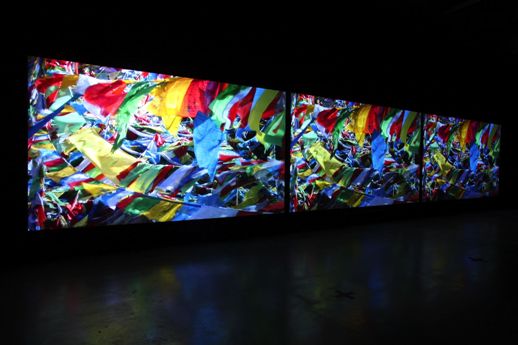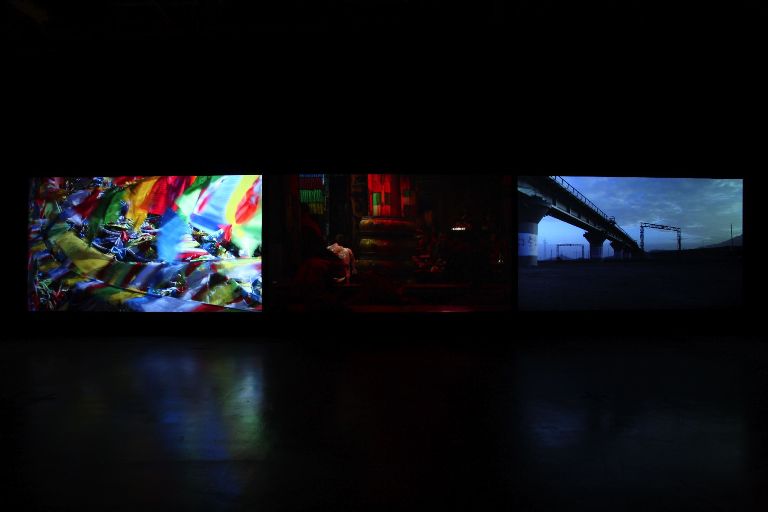Train Spotting
Sculpture, photography, film, live broadcasts: Darren Almond is an artist well-known for his polymath techniques. He has participated in important group shows such as the Venice Biennale (2003) and the Tate Triennale “Altermodern” (2009), as well as exhibiting at the Tate Britain in 2001 and in 2005 at K21 in Dusseldorf, where his work met with much praise and was nominated for the Turner Prize that year. Out of the exhibiters in “Sensation: Young British Artists from the Saatchi Collection” (1997, Royal Academy of Arts), the show that arguably gave birth to the phrase “YBA” for the new generation of UK artists active since the Eighties, Almond was the youngest. In “Sensation” his work was ‘A Bigger Clock’ (1997), inspired by the digital clocks installed on train station platforms. Born in 1971 in Wigan, a town famous for its cotton mills and coal mines, the railroads have fascinated Almond since his youth as something giving access to an unknown world.
“They were my first transport…That’s how I discovered elasticity. You enter stream of consciousness, you are in this kind of stream passage of the landscape. You are being looked at from afar by all the people. This energy that you travel via…through the landscape.”
The self-confessed railway fanatic’s first video work ‘Schwebebahn’ (1995) was filmed at the world’s first suspended monorail in Wuppertal. The Schwebebahn (sky train) was seen as a futuristic flying train when it was constructed in 1901. Projected inverted, in Almond’s work the train seems to run on top of the clouds, yet the passengers and their surroundings appear to be hanging upside down – the result is a very mysterious world indeed.
The artist’s roman along the railways continues with ‘Geisterbahn’ (1999), with a subway train in an amusement park in Prater, Vienna, a reproduction of the world’s first ghost train. Further, with ‘In The Between’ (2006) (shown in 2008 at EYE of GYRE by SCAI the Bathhouse), focusing on the China-Tibet line from Lhasa to Qinhai, Almond completes his Train Trilogy. These three works have been discussed separately at many times but there are few resources looking at how they relate together.
 Courtesy: The artist, Matthew Marks Gallery, SCAI THE BATHHOUSE
Courtesy: The artist, Matthew Marks Gallery, SCAI THE BATHHOUSE
Installation view at EYE OF GYRE, Tokyo" width="518" height="345" />
“I needed to find the third film in order to maintain this vertical kind of axis. And also something that would behold what trains kind of symbolize, and what they are, which is symbols of invasion. After an invasion takes place, there is normally colonization. My local history [is] Great Britain, which was one of the last kinds of the great empires…went through Africa and India, and colonized and implemented an infrastructure which was the railways. And so I follow these kind of veins within the landscape that [are] fueled by the search for energy.”
Finding a railway that fulfills these specific conditions is not easy. But then China began construction of the controversial Tibetan railway. “That was just a perfect railway, because its destination was in the Shangri-la, which was linked back to kind of Victorian period…This utopia hiding in the clouds and unreachable now is the destination of a railway.”
The three screens of ‘In The Between’ show us many scenes. The grassy fields we can see undulating from the train window, surrounded by pure blue skies, create an atmosphere of a dignified highland that connects to a holy land. Tibetan monks chant from the sutras in a scene of prayer, their voices deep and yet seeming to float up to the heavens. Prayer flags fluttering in the wind; passengers staring out of the train windows; army exercises on the railway at night. The synthetic effect of the three screens that stays with the viewer is surely one of China’s threat to the religious heartland Tibet. However, here one can see not just conceptualization, but also morphological re-creations of what the artist saw there.
 Courtesy: The artist, Matthew Marks Gallery, SCAI THE BATHHOUSE
Courtesy: The artist, Matthew Marks Gallery, SCAI THE BATHHOUSE
“Within the film, there’s also a deity at the exit of all temples in Tibetan Buddhism. It is quite an angry kind of deity, with eyes that are bolting out. In the film, on the three screens…there is one part [on the central screen] where it’s quite dark, and the landscape [in the two other screens] forms what would be the brow, and the train passes and comes out like eyes coming out of this deity.”
The eighth century Samyey Monastery, Tibet’s first Buddhist monastery, features occasionally in the film. Here in the monastery’s foothills was discovered the hidden sutras known from the twentieth century as The Tibetan Book of the Dead (Bardo Thodol).
“[It] is a manual to be read as someone is leaving this life and moving on to the next life…Its more accurate title is quite a long title, which ends with the words “in the between”. You are always in the state of moving in the between, in the bardo. This is a perfect title, because the piece sat in between the death and the life from the earlier two films.”
The three works, though separate from each other, are thematically more ambitious as a trilogy. Further, by association with even other series in Almond’s oeuvre, their significance multiples. At his solo show at Matthew Marks Gallery (2007, New York), the piece ‘Mono Chrono Pneumatic Red’ (2007), a hydraulic flip-clock, was shown alongside ‘In The Between’. The front surface displaying the time was covered in the color red, a color that could be said to be a symbol of China. The complex mechanisms operating the clock on its behind were decorated in the five colors of the Tibetan prayer flags (blue, white, red, green, yellow). The film with its theme of China and Tibet, and the huge clock held together by colors hinting at those countries: they both resonate and form a new piece together. While each work is not reliant on another and stands independently, that by coexistence they arrive at and display richness can be said to be the beauty in Almond’s work.
From the activities so far of this artist of many works and techniques it can be seen that the number “three” holds a special meaning. Not just in the Train Trilogy, but the Antarctic-themed video work ‘A’ (2002) is likewise composed of three pieces and his video installation ‘Traction’ (1999), depicting the artist’s parents, is also an altar-like triptych. Even for ‘In The Between’ three screens are employed.
The number three first appears in the early work ‘Fan’ (1997), a moving sculpture of expanding and contracting blades. “[T]he fan has three blades, which is really important, because then you are not dealing with equals and opposites…[T]hey form a triangle…then the triangle is turning in a circle which is within a square. So you have three prime shapes… It’s also an altar representation.”
From this it is not difficult to imagine how much the artist values balance. Almond is an artist with clearly defined ideas and continually raises questions and issues, but whose aesthetic can also be enjoyed for its own sake. And it is indeed due to this very sense of balance that his works are autonomous but also, resisting exclusivity, together further enhance each other.
“I keep kind of three things going at the same time. ‘Fan’ kind of signifies my working method. I move from one blade to the other, from photography into sculpture into more time-based [work].”
Translated by William Andrews
Naomi Matsuura
Naomi Matsuura



